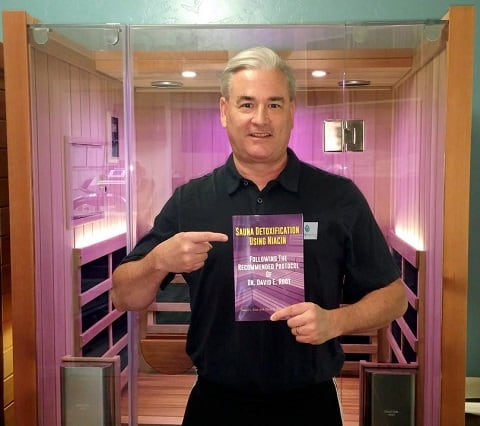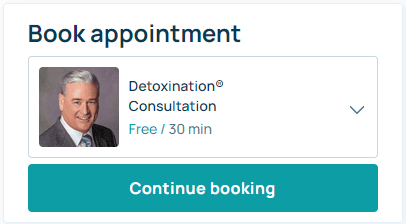Why Gut Health Is the Gateway to Effective Detoxification
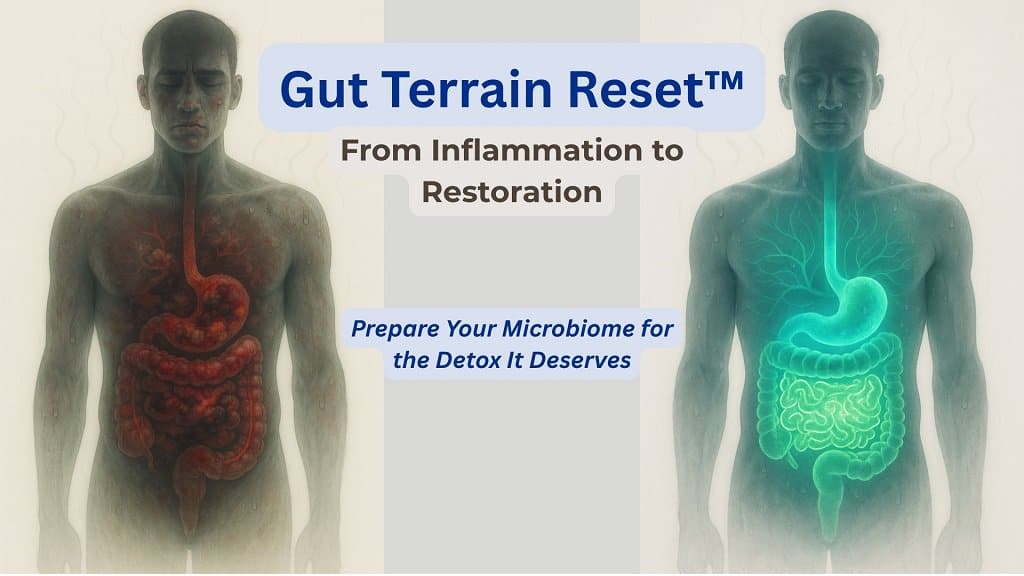
I. Introduction: The Overlooked Foundation of Detox
Everywhere we turn, we’re being exposed to toxins. From the air we breathe and the water we drink to the food on our plates and the products we use daily, environmental toxicants have become an unavoidable part of modern life. As awareness grows, so does the interest in detoxification — and for good reason. The body was never designed to handle the synthetic chemicals, heavy metals, endocrine disruptors, and persistent organic pollutants now saturating our environments.
But here’s the problem: most people approach detoxification backwards.
They jump straight into liver cleanses, juice fasts, coffee enemas, or trendy binders without realizing that the real barrier to successful detox isn’t the protocol itself — it’s the condition of the gut.
Detoxification doesn’t start with your liver.
It doesn’t start with your kidneys.
It starts in the terrain that governs what gets absorbed, what gets excreted, and what gets re-circulated through your bloodstream: your gut.
If your gut is inflamed, leaky, or imbalanced, your detox pathways can’t function properly. Instead of ushering toxins out, your body can reabsorb them — triggering more inflammation, confusion in the immune system, and worsening symptoms.
The truth is, you cannot detoxify effectively if your gut terrain is compromised.
In this article, we’ll explore how your gut — and more specifically, your gut microbiome and intestinal barrier — play a central role in whether toxins get cleared or recycled. We’ll uncover the mechanism behind metabolic endotoxemia, a state of chronic, low-grade poisoning driven by gut dysfunction. And finally, we’ll introduce a new approach that primes the gut for detoxification, laying the foundation for lasting resilience.
Because before you take on the toxins…
You must restore the terrain.
II. Meet the Microbiome: Your Inner Ecosystem
Inside your gut lives a dynamic, intelligent, and essential ecosystem — one that weighs several pounds, houses trillions of organisms, and outnumbers your human cells by at least 1.3 to 1. This is your gut microbiome, and it functions as a command center for your immune system, your mood, your metabolism, and your ability to detoxify.
The gut microbiome contains over 100 trillion microbes, comprising bacteria, fungi, viruses, archaea, and protozoa. Far from being mere passengers, these microbes actively participate in key functions that support your health:
They digest complex fibers and generate critical postbiotics like short-chain fatty acids (SCFAs), including butyrate, which feeds your colon cells and regulates inflammation.
They synthesize nutrients, such as vitamin K2, folate, and certain B vitamins.
They modulate your immune response, training your body to distinguish friend from foe.
They produce neurotransmitters like serotonin and GABA, affecting mood, sleep, and cognition.
And perhaps most importantly in the detox context, they help manage and degrade xenobiotics — foreign chemicals — and regulate barrier integrity to prevent systemic exposure.
This is why the gut is often called your second brain — it communicates bidirectionally with your central nervous system via the gut-brain axis, influences your hormonal rhythms, and sends continuous updates to your immune system. It’s also intricately connected to the gut-liver axis, meaning that whatever happens in the gut, the liver knows about — and vice versa.
When the microbiome is balanced and diverse, it’s like a well-tended garden.
But when it’s disturbed — due to antibiotics, stress, environmental toxins, ultra-processed foods, or infections — it begins to shift. Harmful microbes can proliferate, inflammation rises, and the protective mucus and epithelial lining begin to break down. What results is a compromised terrain that can no longer defend the body from its toxic load.
And that’s where trouble starts.
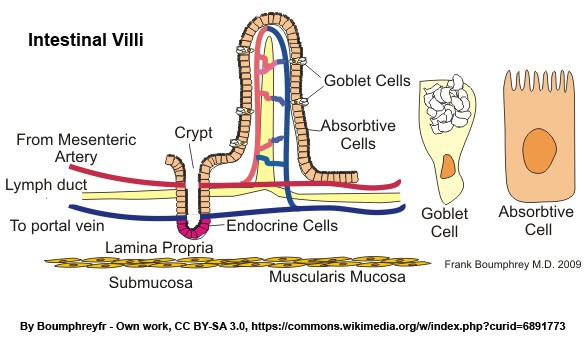
III. The Structure of the Gut Barrier: Your First Line of Defense
To truly understand how gut health influences detoxification, we must take a closer look at the architecture of the gut barrier. Contrary to what most imagine, the inside of your gastrointestinal tract — from mouth to anus — is technically outside the body. Nutrients, bacteria, toxins, and food particles don’t officially “enter” your system until they cross the single-cell-thick lining of your small intestine.
That’s right: the only thing standing between your bloodstream and the outside world is a one-cell-thick epithelial layer, covered in protective mucus, lined with tight junctions, and colonized by microbes. It’s a miracle of design — and it’s under constant threat.
Here are the key players that make up this critical defense barrier:
1. Villi and Microvilli
These are finger-like projections that massively increase the surface area of your small intestine — up to 4,000 square feet, roughly the size of a tennis court. Each villus is lined with epithelial cells that absorb nutrients, while the microvilli on top form the brush border, rich in enzymes and transporters.
2. Tight Junctions
These are protein-based seals that lock epithelial cells together, ensuring that nothing gets between them — a feature called paracellular exclusion. When functioning properly, tight junctions control what gets absorbed and what stays out. When these junctions loosen, a condition known as leaky gut (intestinal permeability) results, allowing harmful substances to pass freely into circulation.
3. Goblet Cells
Scattered among the epithelial cells, goblet cells produce mucus — a slippery, antimicrobial-rich coating that protects the gut lining from pathogens, digestive acids, and mechanical damage. Without enough mucus, the barrier is vulnerable to abrasion and microbial invasion.
4. Secretory IgA (sIgA)
This is an antibody secreted by immune cells embedded in the gut wall. sIgA serves as the immune system’s first responder, tagging harmful microbes and food antigens to neutralize them before they breach the barrier.
5. Microbial Residents
Commensal bacteria help maintain barrier function by producing butyrate, which strengthens epithelial cells and promotes tight junction integrity. They also compete with harmful microbes, keeping the system in balance.
When this barrier is intact, it’s a brilliant filter. It lets in nutrients while keeping out pathogens, toxins, and large food particles. But once the gut lining becomes inflamed, overburdened, or nutritionally deprived, those tight junctions begin to degrade — opening the floodgates for what comes next: Leaky Gut Syndrome.
And that sets the stage for metabolic chaos.
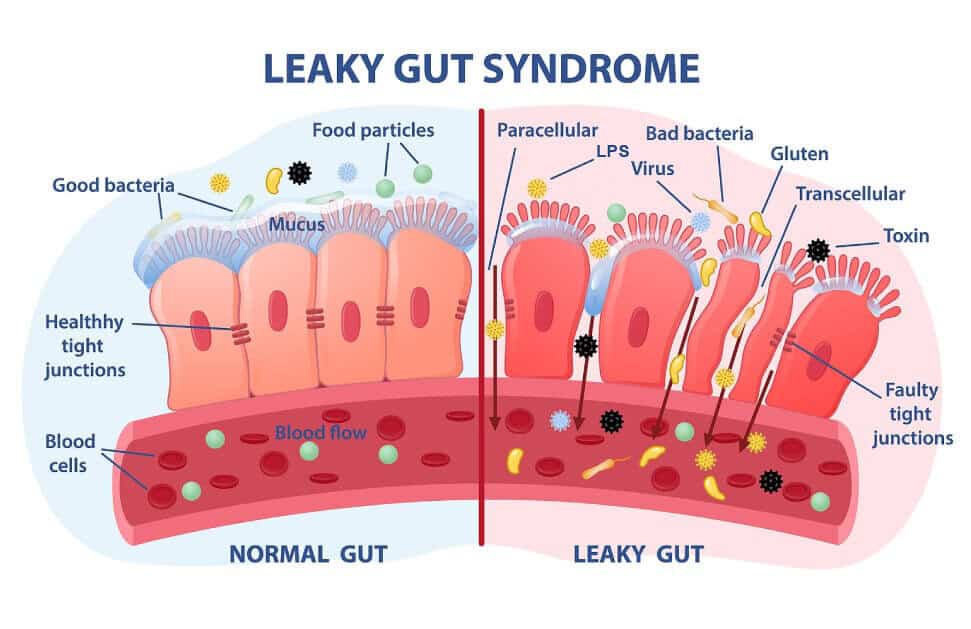
IV. Metabolic Endotoxemia: When the Barrier Breaks
When the gut barrier becomes compromised — due to dysbiosis, chronic stress, inflammatory foods, or toxic exposures — its ability to regulate what enters the bloodstream is lost. This condition, often referred to as leaky gut, marks a pivotal breakdown in the body’s defense system.
At the microscopic level, this breakdown occurs when the tight junctions between epithelial cells loosen. Instead of acting as a selective barrier, the gut becomes porous — allowing particles to “leak” into the bloodstream that were never meant to be there. These include:
Lipopolysaccharides (LPS): Endotoxins from Gram-negative bacteria
Undigested food particles: That provoke immune confusion
Mold fragments, fungal toxins, heavy metals, pesticides
Both environmental and internally generated toxicants
Among these, LPS is the most inflammatory. Normally confined within the gut, LPS is a component of the outer membrane of Gram-negative bacteria. When these bacteria die or multiply excessively, large amounts of LPS are released.
If the gut lining is intact, LPS is safely eliminated. But when the gut is leaky, LPS crosses into the bloodstream where it activates Toll-Like Receptor 4 (TLR4) on immune cells, triggering a powerful release of cytokines like TNF-α and IL-6.
This sustained, low-grade immune activation is called metabolic endotoxemia — and it’s now understood to be a driving force in many chronic conditions, including:
Obesity and insulin resistance
Cardiovascular disease
Non-alcoholic fatty liver disease (NAFLD)
Autoimmune disorders
Alzheimer’s, mood disorders, and neuroinflammation
Chronic fatigue and mitochondrial dysfunction
And critically — detoxification failure
Once this pro-inflammatory state takes hold, the body becomes overwhelmed, reactive, and dysregulated. Mobilizing toxins under these conditions — as traditional detox programs often do — risks recirculation, immune flare-ups, and worsening symptoms.
This is why gut repair isn’t just supportive — it’s foundational.
And resolving metabolic endotoxemia isn’t a side quest — it’s the first strategic move in terrain-based detoxification.
V. How a Broken Gut Blocks Detoxification
The body’s ability to detoxify depends on more than just functioning organs — it requires an intact, well-regulated biological terrain. And the gut is central to that terrain. When the gut is compromised, the entire detox system suffers.
Let’s break down how a leaky, inflamed gut disrupts the three primary pillars of detoxification: mobilization, processing, and elimination.
1. It Overloads the Liver with Endotoxins
The liver is already under siege in today’s toxic environment. But when the gut barrier fails, it becomes a revolving door for endotoxins, microbial metabolites, and pro-inflammatory compounds like LPS. These toxins enter the portal vein, the major vessel connecting the intestines directly to the liver.
Instead of focusing on metabolizing external toxins (like pesticides, solvents, mold toxins, etc.), the liver is now drowning in waste it never should have seen. This overload slows Phase I and Phase II detox pathways, leading to toxin recirculation, hormone imbalances, and oxidative stress.
2. It Disrupts Bile Flow and Enterohepatic Circulation
Healthy bile flow is essential for fat digestion and toxin elimination. But a dysfunctional gut affects bile in two critical ways:
Inflammation and gut dysbiosis impair bile signaling, reducing bile production and flow.
Bile acid deconjugation by dysbiotic microbes turns beneficial bile into damaging, reabsorbed waste products.
This interferes with the enterohepatic circulation — the loop that carries bile and toxins from the liver to the gut for elimination. Without binders or a healthy gut microbiome to break the cycle, these toxins are reabsorbed, causing symptoms to persist or worsen during detox efforts.
3. It Reduces the Effectiveness of Binding Agents
Even if someone is taking binders like zeolite, charcoal, or cholestyramine, a compromised gut can limit their effectiveness. Why?
Increased transit time or mucus degradation may prevent binders from interacting with target toxins.
Inflamed or damaged mucosal surfaces may absorb toxins more rapidly than binders can trap them.
Microbial imbalance affects how bile and conjugated toxins are presented for binding.
This is why some people feel worse on detox binders when their gut isn’t ready. It’s not a reaction to the binder — it’s a reaction to increased exposure to reabsorbed toxins.
4. It Triggers the Cell Danger Response (CDR)
LPS and other microbial byproducts are not just inflammatory — they are mitochondrial disruptors. When these molecules enter systemic circulation, they signal a state of danger at the cellular level, triggering the Cell Danger Response — a protective mechanism that shuts down energy production, nutrient absorption, and cellular repair.
In this state, detoxification becomes nearly impossible. The body doesn’t prioritize healing — it prioritizes defense.
5. It Creates a Terrain Hostile to Nutrient Absorption
Finally, the gut is responsible for absorbing the nutrients and cofactors needed to support detox: B vitamins (especially niacin and folate), magnesium, glutathione precursors, sulfur compounds, and more. If the gut is inflamed or dysbiotic, nutrient uptake is impaired — and detox pathways stall due to lack of fuel.
Bottom Line
If your gut is compromised, it’s not just “harder” to detox — it can be counterproductive. Toxins may mobilize but fail to exit. Binders may be ineffective. And your immune system may treat detox as just another assault.
This is why gut repair must be the primer — the foundation before you flip the detox switch.
VI. Detoxification Depends on the Gut
We often think of detoxification as a liver-centric process — and it’s true that the liver plays a crucial role in neutralizing and conjugating toxins. But what happens after that?
The liver pushes many of its toxic conjugates into bile, which is secreted into the small intestine for final elimination. This means that a significant portion of detox — especially fat-soluble toxicants and bile-bound waste — is completely dependent on gut function.
Three Reasons Gut Function Determines Detox Success
1. The Gut-Bile Axis
Bile carries toxins into the gut for removal — but without a healthy gut, this process backfires. Poor bile flow, microbial imbalance, or compromised motility leads to reabsorption of toxins (a process called enterohepatic recirculation). Instead of exiting the body, toxins cycle back into the bloodstream.
2. The Mucosal Firewall
A healthy gut lining provides a physical and immunological barrier between what’s in your intestines and your internal environment. When this lining is inflamed or degraded — as in leaky gut — it cannot properly regulate what passes through. This means that endotoxins like LPS, undigested food particles, and microbial fragments can cross into the bloodstream, causing systemic inflammation and immune dysregulation.
3. The Microbiome’s Modulatory Role
Gut microbes assist in detoxification by:
Transforming toxins into more or less harmful metabolites
Regulating bile acid metabolism
Modulating immune responses via short-chain fatty acid (SCFA) production like butyrate
But when dysbiosis is present — too many Gram-negative species, not enough keystone bacteria — this helpful role is lost. In fact, the wrong microbial profile generates more LPS and oxidative stress, further taxing the detox system.
Why This Matters Before Detoxination®
If you initiate a toxin-mobilizing protocol — whether through sauna, niacin, fasting, or other means — with a compromised gut, you risk stirring up a toxic storm that your body cannot eliminate effectively.
This is why many people report worsening symptoms during detox attempts:
Fatigue
Brain fog
Skin rashes
Mood swings
Digestive discomfort
These are often signs that the terrain was not ready.
True detoxification is not just about moving toxins out — it’s about clearing them without collateral damage. And that starts with the gut.
VII. The New Model: Terrain-Based Detoxification
Traditional detox approaches often emphasize intensity — more binders, stronger sauna sessions, faster results. But without a healthy terrain to process and eliminate those toxins, the body becomes a battlefield instead of a healing space.
We need a smarter model. One that respects physiology first — not intensity.
Introducing Terrain-Based Detoxification™
Terrain-Based Detoxification flips the script: instead of forcing the body to detox, it restores the internal environment so that detoxification becomes safe, efficient, and sustainable. And the foundation of that terrain is the gut.
By addressing microbial imbalances, gut permeability, bile flow, and mucosal integrity before initiating toxin mobilization, you build a system that can actually handle the load.
This model is the reason we’ve developed the new:
The Gut Terrain Reset™
A 6-week strategic program to prime your gut for safe, effective detox.
The Gut Terrain Reset combines the powerful gut-healing products from Microbiome Labs with the gentle, early-stage toxin-reducing benefits of the Niacin Flush Sauna Detox method — originally developed for firefighters.
You’ll learn how to:
Rebuild your microbiome without overwhelming your system
Repair your gut lining and mucosal barrier
Reduce systemic inflammation and LPS burden
Support bile flow, digestion, and microbial resilience
Introduce niacin and zeolite strategically to offload toxins early — without triggering major mobilization
⚠️ Note: Microbiome Labs products are sold only through licensed practitioners. This program includes instructions to access their products through our portal. Additional product costs apply.
Ready to Reset?
For just $4.99, you can download the full Gut Terrain Reset™ guide — a practical and powerful primer for anyone preparing to begin Detoxination® or looking to break through a plateau in their healing journey.
VIII. Conclusion: Heal the Gut, Unlock the Detox
The path to true detoxification doesn’t begin with high-dose supplements or marathon sauna sessions. It starts at the foundation — the gut terrain. Your microbiome, intestinal barrier, and mucosal immune system are not just passive players; they are the gatekeepers of systemic health and the ultimate regulators of how your body responds to toxic burden.
If your gut is inflamed, permeable, and dysbiotic, then no amount of mobilized toxins will safely leave your system.
But when your gut terrain is restored —
✔️ Your body regains its resilience
✔️ Inflammation calms
✔️ Toxins move out without creating chaos
The Gut Terrain Reset™ isn’t just a gut protocol. It’s a foundational strategy for anyone pursuing deeper healing through Detoxination® or any detox approach.
Take this step before mobilizing fat-stored toxins. You’ll not only feel better — you’ll detox better.
Daniel Root is the leading expert, practitioner, and trainer of Detoxination®. He is the son of the world renowned expert in human detoxification of heavy metals, synthetic/man-made chemicals, and radiation, Dr. David E. Root.
Dan and his father authored Sauna Detoxification Using Niacin that sells thousands of copies worldwide.
He was co-host of a weekly radio program, The Get Detoxinated! Show on KSAC 105.5 FM.
Dan is the CEO of Detoxination Wellness Centers, a dba of Sabre Hawk, LLC.
He has been an entrepreneur in the Information Technology field since 1989, and is the adoptive father of 3 biological sisters.
Dan served on the Board of Sierra Adoption Services for 6 years. He lives with his wife, Suzy, and their youngest daughter in Sacramento, California.
 Click here to learn more about our Testimonials and Results Disclaimer
Click here to learn more about our Testimonials and Results Disclaimer
Disclaimer: Information on this web site is provided for informational purposes only. The information is a result of years of practice experience by the authors. This information is not intended as a substitute for the advice provided by your physician or other healthcare professional or any information contained on or in any product label or packaging. Do not use the information on this web site for diagnosing or treating a health problem or disease, or prescribing medication or other treatment. Always speak with your physician or other healthcare professional before taking any medication or nutritional, herbal or homeopathic supplement, or using any treatment for a health problem. If you have or suspect that you have a medical problem, contact your health care provider promptly. Do not disregard professional medical advice or delay in seeking professional advice because of something you have read on this web site. Information provided on this web site and the use of any products or services purchased from our web site by you DOES NOT create a doctor-patient relationship between you and any of the physicians affiliated with our web site. Information and statements regarding dietary supplements have not been evaluated by the Food and Drug Administration and are not intended to diagnose, treat, cure, or prevent any disease.


